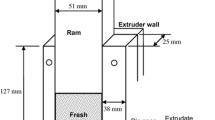Abstract
In this study, FRP tube encased waste tire rubber modified concrete cylinders were investigated. Four batches of confined and unconfined concrete cylinders with a diameter of 101.6 mm and a height of 304.8 mm were prepared. Each batch contained three confined cylinders and three unconfined cylinders. The total number of effective cylinders prepared was 24. Batches 1–3 were made of rubberized concrete. In Batch 1, 15% by volume of coarse aggregate was replaced by waste tire fibers or stripes; in Batches 2 and 3, 15% by volume of sand and 30% by volume of sand were replaced by crumb rubbers, respectively. Batch 4 was a control batch with conventional plain concrete. Uniaxial compression tests were conducted on all the cylinders per ASTM C39. Strain gages were installed on the encased rubberized concrete cylinders to obtain local strain distributions. The compressive strength and strain at the peak load were compared with the predictions by available design-oriented confinement models. It is found that the FRP tube encased rubberized concrete cylinders have higher confinement effectiveness, ductility, and elastic regions than FRP tube encased conventional concrete cylinders. Waste tire fiber modified concrete performs better than crumb rubber modified concrete with a lower cost. Instead of volume contraction, FRP encased rubberized concrete cylinders experience volumetric expansion. The current design-oriented confinement models cannot consistently predict the compressive strength and strain of the encased cylinders. An 1-D coupon test cannot uniquely determine the hoop tensile strength of the FRP tubes which are subjected to a 2-D stress condition.









Similar content being viewed by others
References
Douglah S, Everett JW (1998) Scrap tire disposal: I. Survey of state programs. J Solid Waste Technol Manag 25:40–50
Eldin NN, Senouci AB (1993) Rubber-tire practices as concrete aggregate. J Mater Civ Eng 5:478–496
Khatib ZK, Bayomy FM (1999) Rubberized Portland cement concrete. J Mater Civ Eng 11:206–213
Goulias DG, Ali AH (1998) Evaluation of rubber-filled concrete and correlation between destructive and nondestructive testing results. Cem Concr Aggreg 20:140–144
Lee HS, Lee H, Moon JS, Jung HW (1998) Development of tire-added latex concrete. ACI Mater J 95:356–364
Li G, Stubbelfield MA, Garrick G, Eggers J, Abadie C, Huang B (2004) Development of waste tire modified concrete. Cem Concr Res 34:2283–2289
Huang B, Li G, Pang SS, Eggers J (2004) Investigation into waste tire rubber filled concrete. J Mater Civ Eng 16:187–194
Li G, Garrick G, Eggers J, Abadie C, Stubblefield MA, Pang SS (2004) Waste tire fiber modified concrete. Compos B 35:305–312
Fardis MN, Khalili HH (1982) FRP-encased concrete as a structural material. Mag Concr Res 34:191–202
Mirmiran A, Shahawy M (1996) A new concrete-filled hollow FRP composite column. Compos B 27B:263–268
Li G, Torres S, Alaywan W, Abadie C (2005) Experimental study of FRP tube-encased concrete columns. J Compos Mater 39:1131–1145
Li G (2006) Experimental study of FRP confined concrete cylinders. Eng Struct 28:1001–1008
Li G, Maricherla D (2007) Advanced grid stiffened FRP tube encased concrete cylinders. J Compos Mater 41:1803–1824
Li G (2007) Experimental study of hybrid composite cylinders. Compos Struct 78:170–181
Samaan M, Mirmiran A, Shahawy M (1998) Modeling of concrete confined by fiber composites. J Struct Eng 124:1025–1031
Lam L, Teng JG (2003) Design-oriented stress–strain model for FRP-confined concrete. Construct Build Mater 17:471–489
Mander JB, Priestley MJN, Park R (1988) Theoretical stress–strain model for confined concrete. J Struct Eng 114:1804–1826
Richart FE, Brandtzaeg A, Brown RL (1928) A study of the failure of concrete under combined compressive stresses, Engineering Experimental Station Bull. No. 185. University of Illinois, Urbana, IL
Newman K, Newman JB (1971) Failure theories and design criteria for plain concrete. In: Proceedings of international civil engineering material conference on structure, solid mechanics and engineering design. Wiley Interscience, New York, pp 936–995
Cusson D, Paultre P (1995) Stress–strain model for confined high strength concrete. J Struct Eng 121:468–477
Karbhari VM, Gao Y (1997) Composite jacketed concrete under uniaxial compression—verification of simple design equations. J Mater Civ Eng 9:185–193
Toutanji HA (1999) Stress–strain characteristics of concrete columns externally confined with advanced fiber composite sheets. ACI Mater J 96:397–404
Miyauchi K, Inoue S, Kuroda T, Kobayashi A (1999) Strengthening effects of concrete columns with carbon fiber sheet. Trans Jpn Concr Inst 21:143–150
Saafi M (2000) Design and fabrication of FRP grids for aerospace and civil engineering applications. J Aerosp Eng 13:144–149
Cheng H-L, Sotelino ED, Chen W-F (2002) Strength estimation for FRP wrapped reinforced concrete columns. Steel Compos Struct 2:1–20
Lam L, Teng JG (2002) Strength models for fiber-reinforced plastic-confined concrete. J Struct Eng 128:612–623
Lin HJ, Liao CI (2004) Compressive strength of reinforced concrete-column confined by composite materials. Compos Struct 65:239–250
Jones RM (1999) Mechanics of composite materials, 2nd edn. Taylor & Francis, Inc., Philadelphia
Saadatmanesh H, Ehasni MR, Li MW (1994) Strength and ductility of concrete columns externally reinforced with fiber composite straps. ACI Struct J 91:434–447
Lam L, Teng JG (2001) A new stress–strain model for FRP-confined concrete. In Teng JG (ed) Proceedings of the international conference on FRP composite in civil engineering. Elsevier, Inc., Amsterdam
Acknowledgments
This study was partially sponsored by an NSF/Louisiana Board of Regents Joint Faculty Appointment Program (NSF/LEQSF(2000-01)-NCA-JFAP-10), NSF under grant number HRD 0734845, and a Louisiana Board of Regents/ITRS project (LEQSF(2004-07)-RD-B-05). The specimens were prepared and the tests were conducted in the Concrete Laboratory at the Louisiana Transportation Research Center (LTRC). The FRP tubes were provided by EDO Specialty Plastics. The assistance by Mr. Randy Young from LTRC and Mr. Manu John at Louisiana State University is greatly appreciated.
Author information
Authors and Affiliations
Corresponding author
Rights and permissions
About this article
Cite this article
Li, G., Pang, SS. & Ibekwe, S.I. FRP tube encased rubberized concrete cylinders. Mater Struct 44, 233–243 (2011). https://doi.org/10.1617/s11527-010-9622-8
Received:
Accepted:
Published:
Issue Date:
DOI: https://doi.org/10.1617/s11527-010-9622-8




